Carnivorous Plants Story
Picture book for a young audience /
Kindle Edition
by
Makoto Honda
Copyright (c) 2013-2017 by Makoto Honda.
All Rights Reserved.
_______
Venus Flytrap
GENUS Dionaea
The Venus flytrap grows in the coastal savanna of North and South Carolina in the United States. This is the only region in the world where the Venus flytraps occur naturally. The botanical name of the plant is Dionaea muscipula. The plants typically grow on the bed of sphagnum moss or on the surface of moist sand in a savanna sparsely populated with trees.

The
natural habitat of the Venus flytrap, in May, in North Carolina. The plant grows
in a moist sandy soil in a pine forest. The Venus flytrap is a sun lover, and
grows best in a sunny locale. Note a small flower stalk just emerging from the
rosette center. Accompanying carnivorous plants include sundews, terrestrial
bladderworts, and some pitcher plants.

Traps of
Venus flytrap plants growing in North Carolina, in July. Note the trap in front
is tightly sealed, indicating the digestion of the victim is well underway.
The Venus flytrap uses a snap-trap, considered by many botanists to be the most advanced of all trapping mechanisms used by carnivorous plants. The trap portion of the leaf consists of two clamshell-like lobes connected along the midrib. Around the margin of each lobe grow stiff, spine-like guard hairs. Along the edge of each lobe, just below the guard hairs, runs a band of nectar glands that produce a sugary substance. This is an attractant to lure potential prey to this deadly trap. Much of the inner lobe below is covered with hundreds of digestive glands, which often paint the trap with a brilliant red color. On the inner surface of each lobe are three tiny hairs. These are called trigger hairs and are sensitive to stimulation.

A leaf of
the Venus flytrap. Note three tiny hairs growing in a triangular position on
each lobe surface. These are sensitive hairs that trigger trap closure.

Digestive
glands covering the inner lobe surface of the trap. These glands are often
colored red, which create a visual attraction for unwary prey. These glands
produce digestive juices when the prey is captured.

A trigger
hair growing on the inner surface of the trap lobe. There are three hairs on
each lobe surface. These hairs are sensitive to stimulation. When an insect
brushes these hairs, the trap snaps shut, entrapping the prey between the two
lobes.

A leaf of the Venus flytrap consists of a petiole (leaf stem) and a leaf blade that is modified to function as a snap-trap. The trap is composed of two semi-circular lobes connected along the midrib. The free margin of the lobe is lined with stiff spines, or guard hairs. There are two pairs of three tiny bristles on the lobe surface. These are trigger hairs which are sensitive to stimulation.

Glands on
the surface of the trap lobes.
When an unwary insect brushes these hairs, the trap snaps shut instantly, usually less than half a second. The guard hairs of each lobe mesh together, forming a bar to prevent the insect's escape, and the hapless prey is confined between the lobes. The insect's effort to free itself further irritates the trap, causing the lobe to close more tightly with a powerful force. This pressure sometimes crushes a soft-bodied insect prey.

Venus
flytrap and a spider. In nature, flies and spiders are among the most commonly
trapped prey for the plant.

Venus
flytrap pinching a freshly caught wasp.

Multi-exposure photography showing a swift trap leaf closure. Note that the
marginal spines (guard hairs) of the two lobes quickly form a retentive bar to
prevent the prey's escape.


A cross
section of the trap of a Venus flytrap (left) immediately after trap closure.
Note that initially there is a large space inside the trap. As the trap
continues to close more tightly, the space in the trap cavity gets smaller and
smaller, often crushing the trapped insect to death.

A Venus
flytrap catching a fly.




Clock-wise
from upper-left: A fly enters an open trap; the moment the trigger hairs are
touched twice, the trap snaps shut; the marginal spines intermesh to form a bar
to prevent insect escape. Lower-right: Two days later, the lobes are tightly
sealed and the digestion is taking place. Note the pressure of the lobes is
strong enough to crush a soft-bodied insect.

The moment an insect brushes one of the trigger hairs the second time, the trap snaps shut, incarcerating the victim. The trap lobes continue to close more tightly, exerting pressure on the trapped insect. Eventually, the digestive juices fill the trap cavity, digesting the victim. When the absorption of nutrients is complete, the trap opens slowly, revealing the skeleton of the consumed victim.
As the two lobes are tightly sealed, the trap becomes filled with digestive juices from the digestive glands and the trapped animal begins to dissolve. The trap remains closed during the digestive process, which may last for a week to ten days depending on the size of the prey. After all the nutrients of the victim are absorbed by the plant, the trap slowly opens. Inside the now dry trap is the remains of the consumed insect prey. Wind and rain will clean the lobes, and the trap is ready again for its next meal. A single trap is usually capable of repeating this process only a few times during the life of the trap. After that it becomes insensitive to stimulation and dies away. New trap leaves are constantly sprouting from the rosette center of the plant during the growing season of spring through fall.

A back-lit
image of a closed trap showing the shadow of a fly submerged in the digestive
juices.
When a trigger hair is stimulated by a piece of wood - or a finger - the trap also snaps shut. In this case, however, the trap opens the next day, since the plant did not find any nutritious object inside. It is known that, in order to close the trap, two stimulations are necessary: Either two different trigger hairs must be stimulated, or a same hair must be stimulated twice, to trigger the trap closure. This is a plant's clever way of making sure that the prey is well situated in the center of the trap before firing the trap. This also reduces a false alarm by wind blown debris. Considering the enormous amount of energy that is needed to close the trap - for a tiny plant - the Venus flytrap cannot afford too many misses.
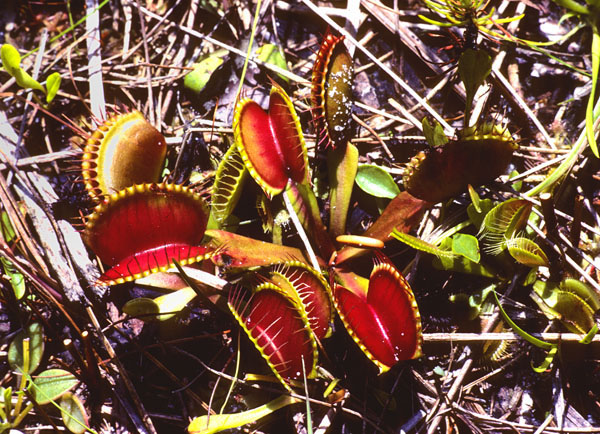
A vigorous
Venus flytrap plant growing in the native North Carolina habitat. In July.
In the months of May through June, many white flowers bloom at the top of a tall flower stalk rising from the rosette center of the plant. The tall stalk provides a safe distance for the pollinators from the deadly trap on the ground. Seeds mature by mid-summer in their natural habitat, and tiny Venus flytrap babies are produced by the end of fall. It takes three to four years for the seedlings to reach a flowering age.
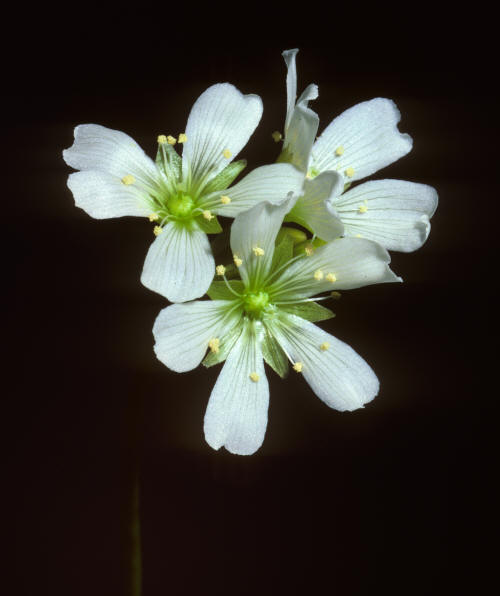
The elegant,
white blossoms of the Venus flytrap. In North Carolina, the blossoms start in
early June.
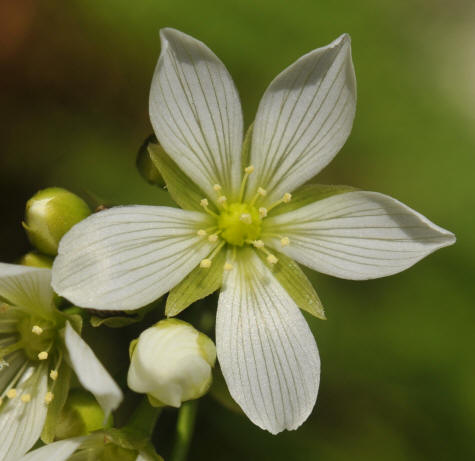
The flower
has five petals and five sepals. Greenish veins run through the white petals. A
flower typically opens for a few days. A slender flower stalk usually bears 10
to 15 flowers at the top (right).
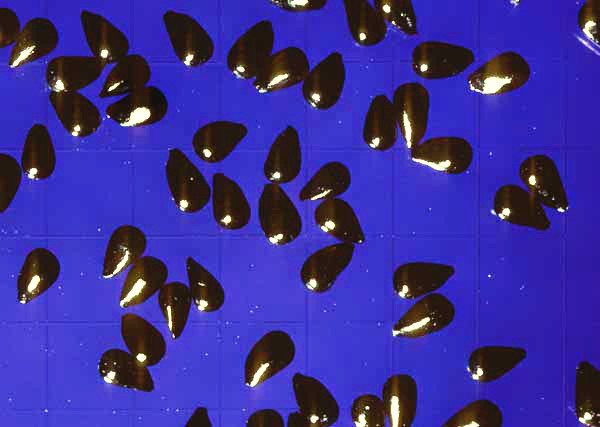
Jet-black,
pear-shaped seeds of the Venus flytrap, measuring 1 mm in length. (The
background scale in the photograph is 2 mm.)
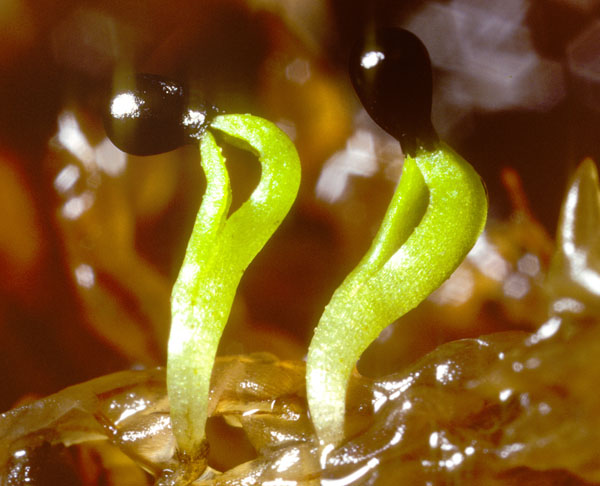
One-week old
babies of the Venus flytrap.
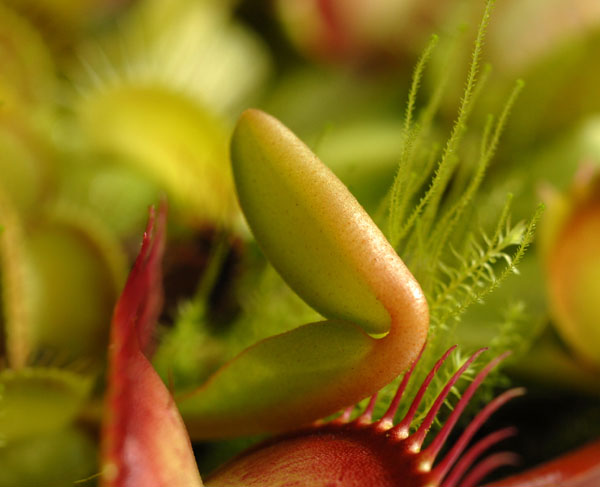
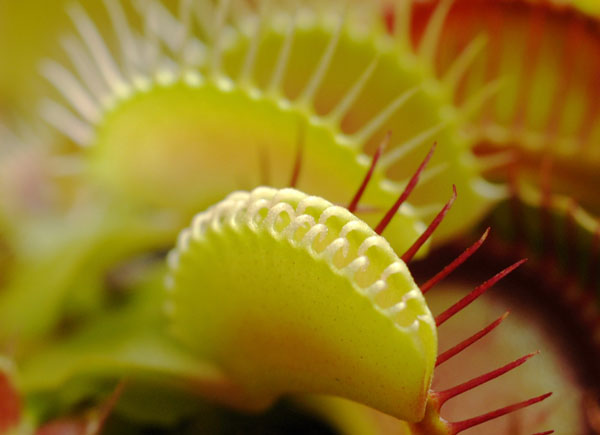
A new leaf
sprouting out of the rosette center of the plant (left), and a new trap about to
open. Note the marginal spines which are starting to unfold.
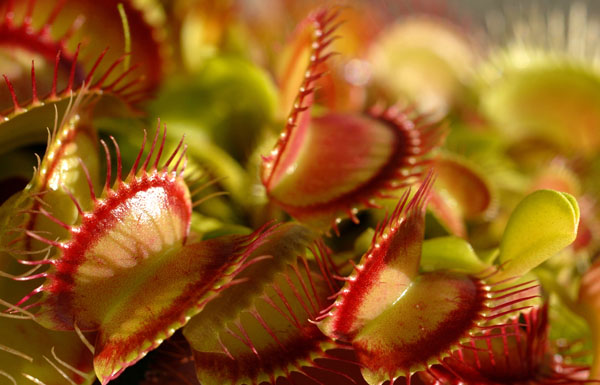
Fully
matured traps of the Venus flytrap, with attractive bright red margins.
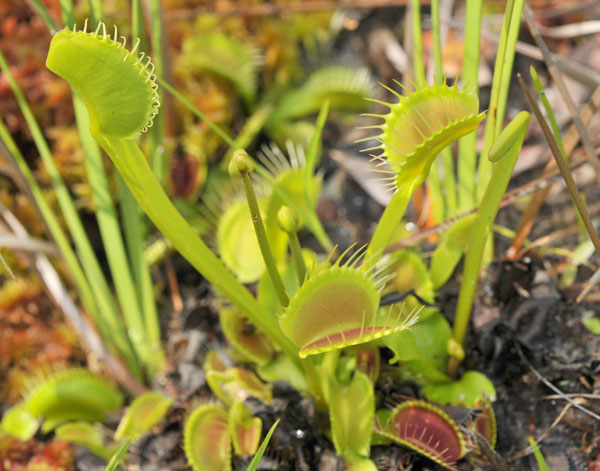
A
transplanted population of the Venus flytrap in the Florida panhandle, in May.
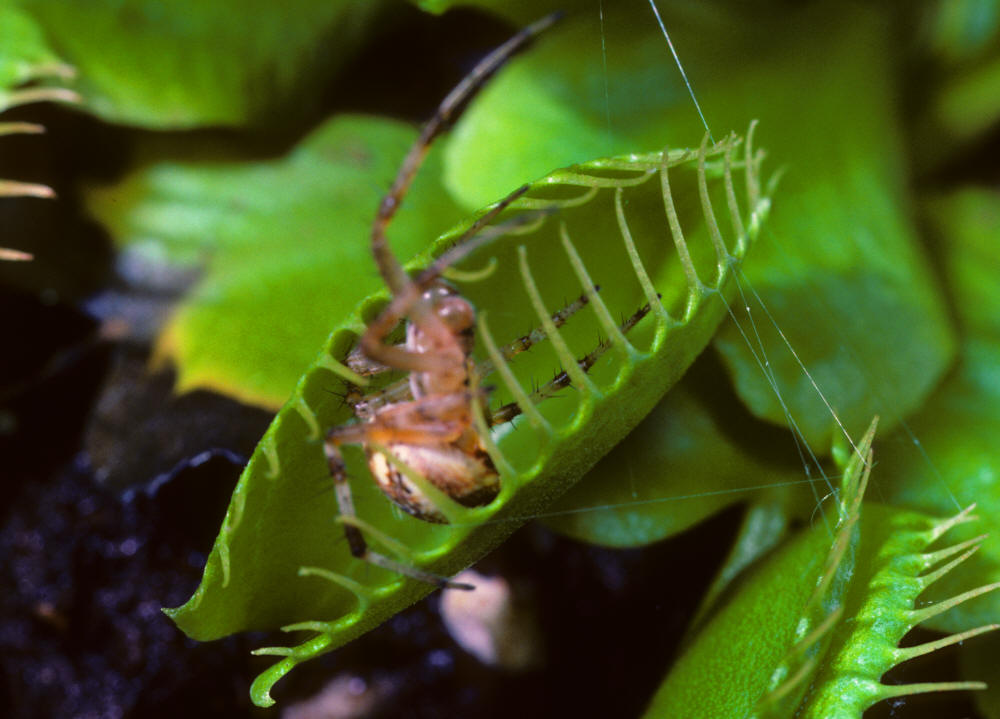
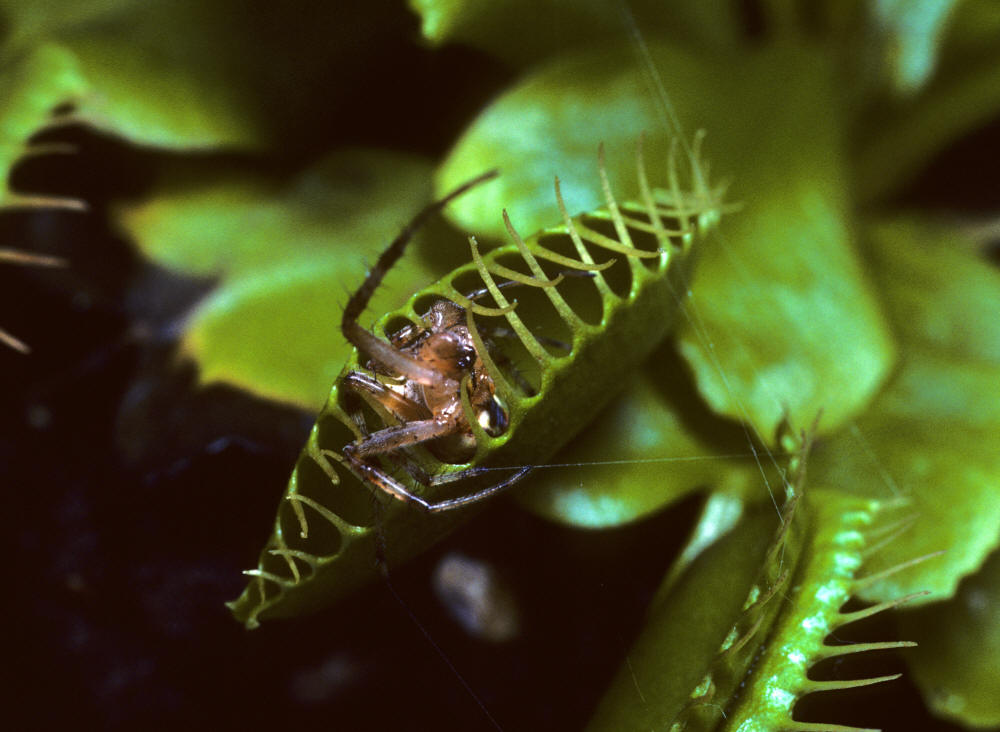
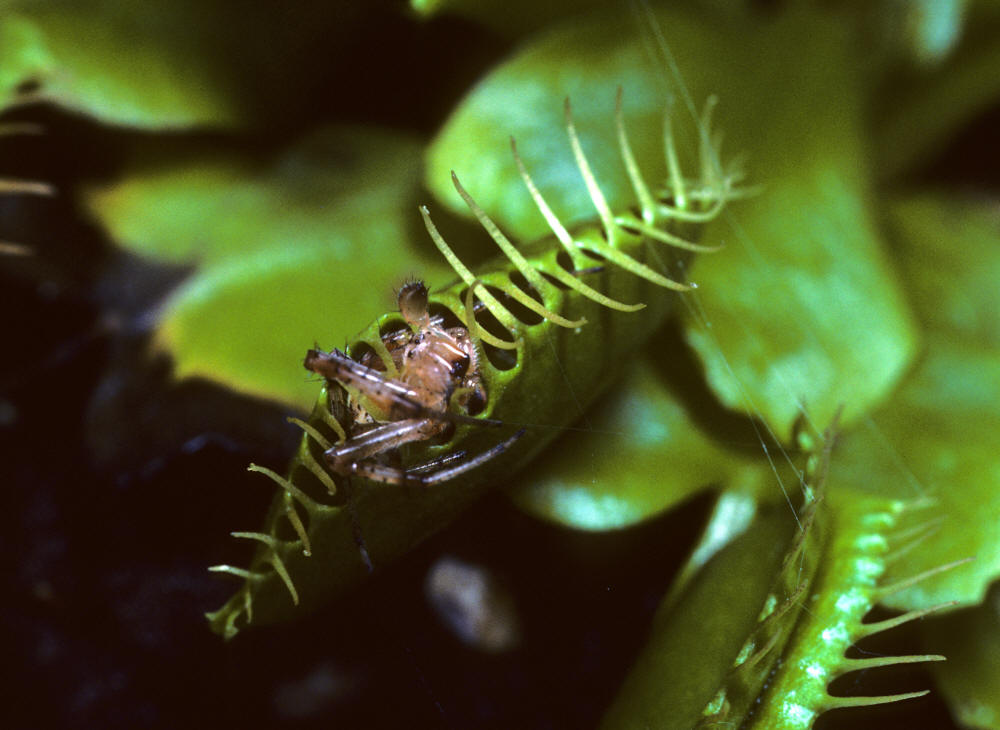
A Venus
flytrap imprisoning a passer-by.
INTRODUCTION
PITFALL TRAPS FLYPAPER
TRAPS SNAP-TRAPS
SUCTION TRAPS VENUS
FLYTRAP SUNDEWS
PITCHER PLANTS COBRA
PLANT BUTTERWORTS
BLADDERWORTS
Carnivorous
Plants Story - Copyrighted Material
Copyright (c) 2013 by Makoto Honda. All Rights Reserved.
Email: mhondax@gmail.com
__________________
For
a young audience, click
here for
"Eaten Alive by Carnivorous Plants" by Kathleen J. Honda & Makoto Honda